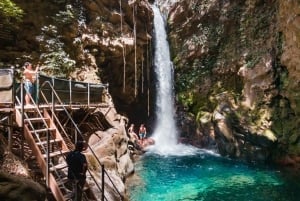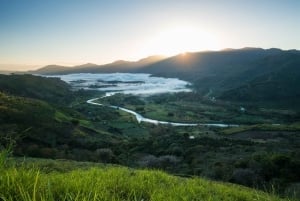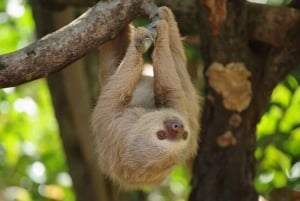The Best Coffee in the World
Editorial
in essence, you will experience the life of coffee from seed to cup
Book Top Experiences and Tours in Costa Rica:
If youʻre booking your trip to Costa Rica last minute, we have you covered. Below are some of the top tours and experiences!
View All Experiences
The alarm clock on my iPad went off at 5:30 am. I slowly rolled over, clicked the off button and started rubbing my eyes as my feet hit the concrete floor of the house I rented in the small mountain town of Orosi, located just outside of Cartago in the Central Valley of Costa Rica. The sounds of birds saying good morning to each other reached my ears as I started 'sleepwalking' towards the kitchen. I stumbled around clumsily as I started my morning ritual of boiling water and pouring coffee grinds into the "sock" filter attached to the wall in order to make the world's best cup of coffee. As I sat on the front porch watching the world wake up, I started wondering about the history of Costa Rican coffee and the "cup of joe" that was bringing me back to life.
Coffee Plantation Tours
There is no better way to learn about coffee's history and production than taking one of the many tours offered by Costa Rican
coffee plantations. You will find coffee tours in the West Valley, Tarrazu, Tres Rios, Orosi, Brunca, and Turrialba regions among others. You will learn about the history of coffee, enjoy tasting different blends, experience what life is like for the growers, pickers, and roasters, as well as learn about how different microclimates effect taste and other characteristics of the bean in more detail than described here. In essence, you will experience the life of coffee from seed to cup. Most tours are around 2 hours and include lunch or dinner, tastings called cuppings and if you're lucky, an ox cart ride. These colorful carts have been used by farmers for many years to take their products to market. Â One of our favorite places to experience a working coffee farm and spend a few nights relaxing is Finca Rosa Blanca Coffee Plantation and Inn. This gorgeous 5 star and 5 leaves boutique (highest rating for being sustainable) hotel sits on 40 acres of pristine land where they grow organic shade coffee. If you are looking for a romantic get away, this may be the perfect place for you.
Finca Rosa Blanca has a full service spa, restaurant and offers a wide variety of tours. Some other popular tours are provided by Britt Coffee, Doka Estates, Terrazu, and Espiritu Santo.

Why Costa Rican Coffee is the Best in the World
Two of my favorite things in life are drinking a strong cup of coffee in the morning and enjoying a delicious glass of wine with dinner. These pleasing libations share several characteristics. We talk about both using terms such as flavor, acidity, body, aroma  bitterness, sweet, smooth, and harsh. Production of both are similar, and altitude, region, temperature, rainfall, and soils are critical to taste and transmit specific characteristics upon both. This hints at why Costa Rican coffee is so darn good. Costa Rica is home to 112 volcanoes (only 5 considered active). As volcanoes erupted throughout history, they deposited minerals into the ground that release slowly over time making the soil "forever" fertile and perfect for growing coffee. Two distinct seasons in Costa Rica also help coffee plants achieve perfect balance. The rainy season (May - November) enjoys hot sunny morning and refreshing rainy afternoons which promote plant growth. Dry season (December - April) is characterized by intense, sunny days that help coffee beans ripen. Altitude contributes enormously to coffee's (and wine's) taste profile. Elevations from 3,000 to 6,000 feet are ideal for coffee, and the crisp mountain temperatures make for a slower maturation which translates to more complex sugars and more desirable flavors. To top it all off, Costa Rica takes coffee production so seriously that it passed an executive order that banned cultivation of any variety other than
Arabica which is considered the finest in the world. Costa Rica's many volcanoes, rich soil, mountainous landscape, distinct seasons, and year round warm weather all contribute to make it's coffee the best in the world. Don't trust me when I say it is the best.
Starbucks, the largest coffee chain in the world, made Tarrazu coffee from Costa Rica the most expensive cup of joe in the world, displacing
Jamaica Blue Mountain coffee in November of 2012.

A Brief History of Coffee in Costa Rica
My research started with how coffee arrived in Costa Rica and the impact it had on the economy and culture. I found that coffee was first introduced to this small central American country by a trader from Panama named Agustin de Gana in 1779. He sent two pounds of coffee beans to Don Jose Vasquez who was Governor of at the time. Coffee remained a rare and hard to get commodity until Father Feliz Velarde left a small piece of land planted with coffee to his neighbors in 1816. Four years later, Costa Rica was exporting small amounts of coffee to . Â Costa Rica won it's independence from Spain in 1821 and the newly established government needed revenue. They soon realized that coffee could be beneficial to the national economy and offered land to anyone who would grow and harvest this new cash crop. Coffee grew amazingly well in the mountain's rich with
volcanic soil and, in 1829, coffee surpassed sugar, tobacco and cacao to become the leading source of revenue for this small third world country. This was a tremendous boost for Costa Rica and the opportunities that followed changed the social and natural landscape by bringing in modern infrastructure such as printing presses and railroads connecting the Central Valley to the Atlantic coast. It funded trips to Europe for Costa Rican scholars that eventually become national leaders and entrepreneurs that used their knowledge to better their home country. The National Theater, one of Costa Rica's architectural treasures, was initially funded by a tax on coffee exports and is a testament to coffee workers that had such a strong influence on their newly established country. It is astonishing to think the coffee plant made such a lasting impact on Costa Rica.
Â
We strongly recommend that you grab a bag of Costa Rican coffee to enjoy while you visit. Ticos take breaks throughout the day to drink a cup of cafe and enjoy the company of co-workers, family and friends. This drink has left it's mark on, and has a place in the history of this amazing country. We believe that you'll find, like a glass of wine coffee can be enjoyed anytime of the day.
Â
Photo Credits: Orosi Valley taken by Dirk van der Made - Photos of Coffee Basket and Ox Cart by Finca Rosa Blanca















